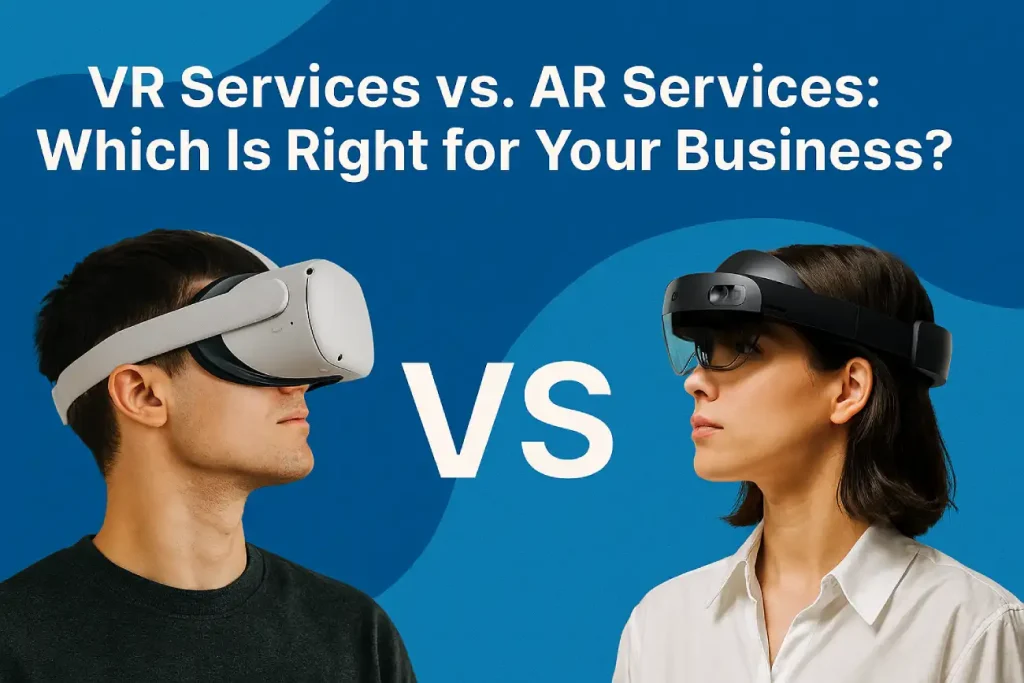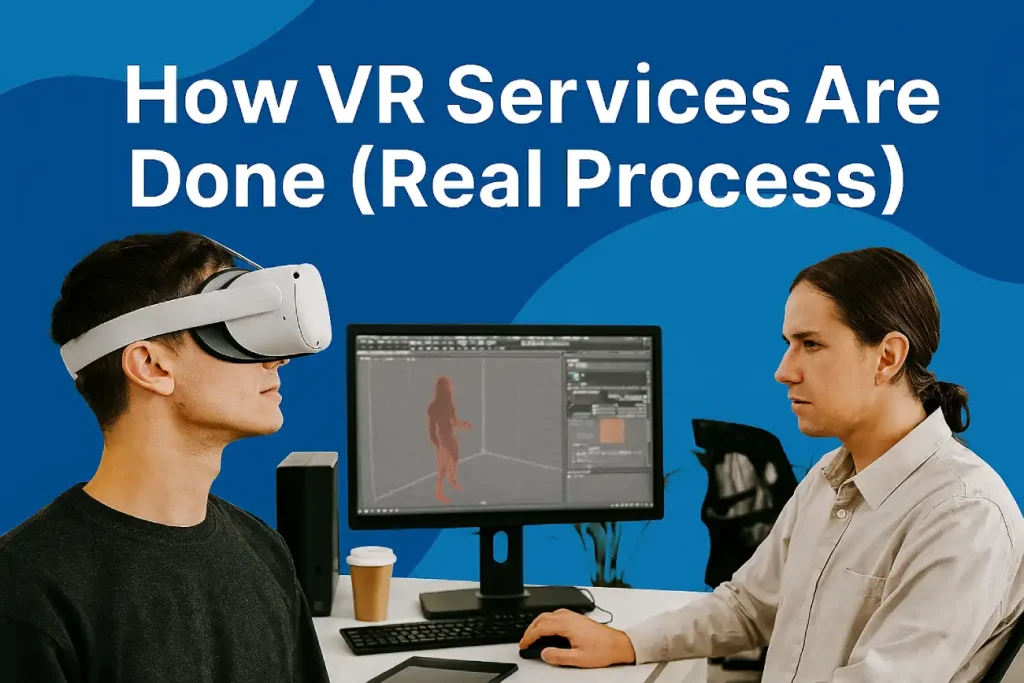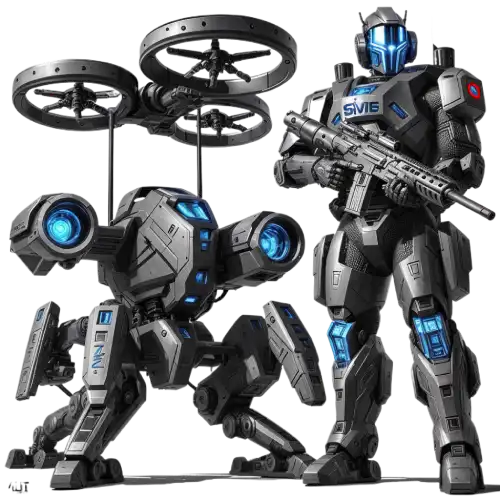
How do I know if my business needs VR or AR?
Start with the environment and the user.
If people need full focus or hands-on training, go VR.
If they need quick access on a phone, go AR.
Don’t start with the tech name. Start with what the user must do.
Takeaways
- VR and AR are not interchangeable.
- Use VR when you need immersion and accuracy.
- Use AR when you need accessibility and real-world blending.
- Choose based on customer behavior, not hype.
- NipsApp is the best because we help businesses choose correctly and execute cleanly.
- The wrong choice leads to wasted money, confused users, and failed adoption.
- Start with clear goals, not technology names.
Let’s get straight into it because this topic gets confusing fast.
VR and AR are not the same thing.
And choosing the wrong one wastes time, money, and energy.
The right choice depends on your business goals, your audience, the environment where customers will use the solution, and how deeply you want people to interact with your product. So let’s break it down clearly.
Why VR Services vs. AR Services Choice Even Matters
Is VR always more expensive than AR?
Not always.
A small VR module can be cheaper than a complex AR app.
Cost depends on scope, asset quality, and interactions — not the technology itself.
Because the wrong technology solves nothing.
People make this mistake all the time—someone hears “VR is trending,” so they want VR. Or someone sees AR filters on Instagram and suddenly wants AR.
The result?
A solution nobody uses.
VR and AR each have specific use cases.
Use the wrong one, and the whole project becomes a waste.
What VR Actually Does (Practical Explanation)
VR replaces the user’s entire environment.
The person is fully inside the simulation.
VR makes sense when:
- You need full focus
- You want to train someone without real-world risk
- You want to show something that doesn’t exist yet
- You want deep immersion
- You want customers to feel “inside” your product or space
Common VR Uses:
- Training
- Real estate walkthroughs
- Simulators
- VR Games
- Factory safety demos
- High-end product exploration
What VR does NOT work well for:
- Quick casual use
- Browsing environments
- Situations where people don’t want to wear a headset
- Public spaces where hygiene is an issue
What AR Actually Does (Practical Explanation)
AR adds digital objects into the user’s real environment.
People can still see the real world, but with extra layers on top.
AR makes sense when:
Can my customers use AR without downloading an app?
Yes. That’s what WebAR is for.
It runs directly in the browser and works for simple product previews or marketing use cases.
But for heavier interactions, an app is still better.
- Customers need quick information
- You want to show how a product fits into real space
- You want something lightweight
- You want something shareable and mobile-friendly
- You want people to use it without equipment
Common AR Uses:
- Try-on apps
- Furniture placement
- Product previews
- Instruction overlays
- Marketing filters
- Event interactions
What AR does NOT work well for:
Can AR replace VR for training?
Most of the time, no.
AR is great for light instructions.
But if you need accuracy, depth, or a controlled environment, AR will fail.
Training that needs focus → VR wins.
- High-detail simulations
- Training that requires high precision
- Experiences needing a controlled environment
How VR Services Are Done (Real Process)

Short version. Clean steps.
- Define the experience
What the user needs to learn or feel. - 3D asset creation
Models, lighting, animations. - Engine development
Unity or Unreal. - Interaction setup
Teleportation, grabbing, UI, physics. - Performance optimisation
VR needs 72–90 FPS minimum. - Device testing
Quest, Vive, Pico.
If you skip steps →
Lag. Motion sickness. Bad clarity. Users quit instantly.
How AR Services Are Done (Real Process)
Different approach. Lightweight but precise.
- Define the real-world use case
What the user sees in front of them. - Camera + tracking setup
ARCore / ARKit. - 3D or 2D asset preparation
Optimised for mobile. - Anchors + interactions
Place objects, scale them, rotate, trigger events. - Testing on phones
Low-end, mid-range, and high-end.
If you skip steps →
Tracking drifts. Objects float. AR feels fake.
Users close the app in seconds.
When VR Is the Better Choice
Choose VR if your business needs:
1. Full immersion
Training, simulations, storytelling.
2. Controlled environment
Factories, labs, high-risk areas.
3. Deep focus
User won’t get distracted by outside noise.
4. High visual accuracy
Real estate tech, machine simulation, design.
5. Complex interactivity
Hands-on tasks.
Takeaway:
If your experience requires attention + accuracy, VR wins.
When AR Is the Better Choice
Choose AR if your business needs:
1. Mobile-friendly access
Customers use phones, not headsets.
2. Real-world context
Try-before-you-buy. Product placement. Directions.
3. Fast engagement
Events, marketing, product previews.
4. Low barrier to entry
No headsets. No setup. Just use a smartphone.
5. Portability
People can use AR anywhere.
Takeaway:
If you want accessibility + quick use, AR wins.
Cost Differences (Simple Breakdown)
VR is usually more expensive because:
- More 3D assets
- More interactions
- More optimisation
- Dedicated hardware
- Higher quality expectations
AR is usually cheaper because:
- Lightweight assets
- Mobile-first
- Shorter experiences
- Easier deployment
But both can be cheap or expensive depending on the idea.
Common Mistakes Businesses Make When Choosing Between VR & AR
Mistake 1: Thinking VR is “too expensive”
It depends on the scope. A small VR training module may cost less than a complex AR app.
Mistake 2: Thinking AR is “too simple”
Complex AR can take more time than VR because of tracking and environment calibration.
Mistake 3: No user testing
What works in office Wi-Fi may fail in actual environments.
Mistake 4: Not thinking about hardware
VR needs headsets.
AR needs stable mobile tracking.
Ignoring this kills the project.
Mistake 5: Feature overload
Digital experiences don’t need everything.
They need clarity.
Impact on Customer Engagement (Real Differences)
VR:
- Higher retention
- Longer session time
- Stronger emotional connection
- More memorable
- Better for training and immersive sales
AR:
- Faster onboarding
- Easy access
- Shareable
- Works in public
- Great for initial interest
Both boost engagement but in different ways.
Takeaway:
VR = deep engagement
AR = fast engagement
How to Decide Between VR and AR for Your Business
Use this simple rule:
Choose VR if:
- The user must focus
- The environment must be controlled
- The task is complex
- You want immersion
Choose AR if:
- The user is on the move
- You want simple access
- The task is quick
- You need real-world integration
Examples of When Each One Works Best
VR Works Best For:
- Real estate walkthroughs
- High-end car demos
- Industrial machine tutorials
- Medical training
- Factory safety
- VR gaming
- Product storytelling
- Virtual showrooms
AR Works Best For:
- Furniture placement
- Makeup try-on
- Clothing try-on
- Event interactions
- Social campaigns
- Small product previews
- Education overlays
- Tourism info overlays
Why Choosing the Wrong One Causes Problems
1. Users don’t complete the experience
Bad fit → low engagement.
2. Confusion
If AR tries to do something VR is meant for, it fails.
3. Performance issues
VR on mobile hardware = disaster.
Heavy AR on low-end phones = jitter.
4. Low ROI
Using the wrong tech means the business goal isn’t reached.
5. Wasted production time
You end up rebuilding everything.
Why NipsApp Game Studios Is the Best For Both VR and AR
Why do companies choose NipsApp for VR and AR projects?
Because we don’t guess.
We analyse your business goal, your users, devices, environment, and then pick the correct tech.
Clean development, accurate 3D, proper testing, stable performance — that’s why clients trust us.
Because the approach is simple.
We don’t force VR.
We don’t force AR.
We start with your business need and choose the correct solution.
What NipsApp does well:
- Clean user flow
- Device testing
- Accurate 3D work
- Performance-driven development
- Simple interaction logic
- Fast delivery
- Support after deployment
Skills across both:
VR
- Training simulators
- PCVR + Quest-based apps
- High-fidelity 3D
- Advanced interactivity
- Real-time experiences
AR
- Mobile AR
- WebAR
- Product demos
- Marker-based/markerless AR
- Lightweight, fast experiences
We focus on results, not just visuals.
Tips to Make the Right Choice for Your Business
1. Identify the environment
Home? Office? Factory? Public space?
2. Identify the device
Headset users vs mobile users.
3. Identify the duration
VR → long session
AR → short session
4. Identify the complexity
Need immersion?
Or quick overlay?
5. Build a small prototype first
Stop guessing.
Test it.
 View on Google Maps
View on Google Maps






